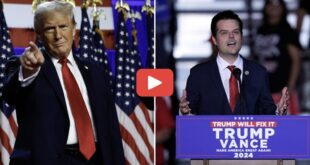Amid swirling rumors about his declining health, Iran’s Supreme Leader, Ayatollah Ali Khamenei, was seen meeting with an international envoy in Tehran, quelling speculations that had suggested he was in critical condition. The publicized event comes at a time when discussions surrounding Khamenei’s potential successor have gained significant traction, with his son, Mojtaba Khamenei, often cited as a key figure in the debate.
Dispelling Rumors of Illness
Reports had surfaced earlier suggesting that Khamenei, 85, had been in a coma following complications from an undisclosed medical condition. However, state media aired footage of the Supreme Leader engaging in a formal discussion with a foreign delegate, seemingly aimed at dispelling these claims. While the authenticity of such appearances has previously been questioned by critics, the video appeared to show Khamenei in stable condition, addressing issues related to regional politics and bilateral relations.
Rising Attention on Mojtaba Khamenei
The episode has reignited speculation about the Supreme Leader’s health and succession plans. Mojtaba Khamenei, a cleric who wields significant influence behind the scenes, has increasingly been seen as a potential successor. His growing presence in political and clerical matters has led analysts to view him as the likely heir to Iran’s leadership, though the official process for selecting a new Supreme Leader involves the Assembly of Experts.
Critics argue that Mojtaba’s ascension would further entrench power within the Khamenei family, a prospect that some factions within Iran’s political landscape find contentious. Nevertheless, his reputation as a pragmatic and authoritative figure continues to bolster his candidacy among hardliners.
Regional and International Reactions
The timing of these developments is particularly significant, given the current geopolitical tensions in the Middle East. Iran’s leadership has faced increasing scrutiny from Western powers, particularly over its nuclear program and its role in supporting militant groups across the region. The speculation surrounding Khamenei’s health and succession plans has added an additional layer of uncertainty, with foreign governments closely monitoring the situation.
While official statements have sought to downplay the rumors, international observers remain cautious about potential shifts in Iran’s leadership. Any change at the helm could have profound implications for Iran’s domestic policies and its approach to foreign relations, particularly with key adversaries like the United States and Israel.
A Deliberate Message
Khamenei’s public appearance is widely viewed as a strategic move to reaffirm his position and maintain stability within the regime. By addressing a foreign envoy, the Supreme Leader also signals continuity in Iran’s foreign policy, emphasizing that the leadership remains unified and functional despite rumors of internal challenges.
As speculation continues, the coming weeks are likely to shed more light on the future of Iran’s leadership and the role Mojtaba Khamenei might play in shaping the country’s direction. For now, the Supreme Leader’s calculated response underscores the importance of optics in preserving authority amid growing uncertainties.
 Trending News
Trending News
